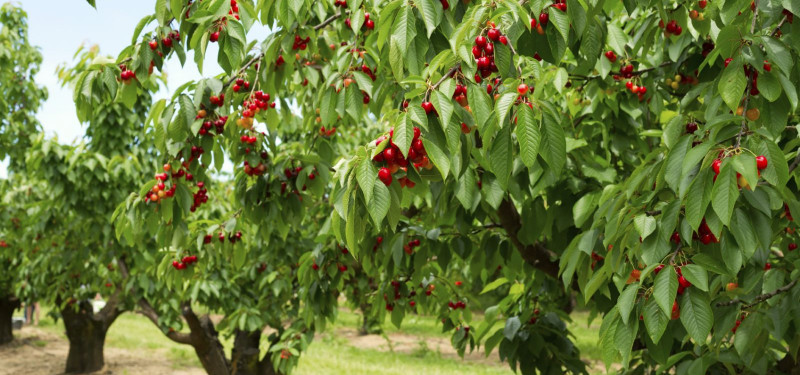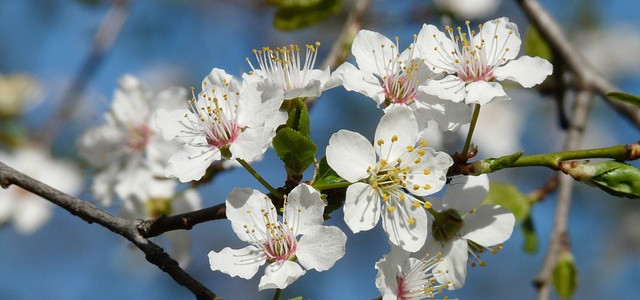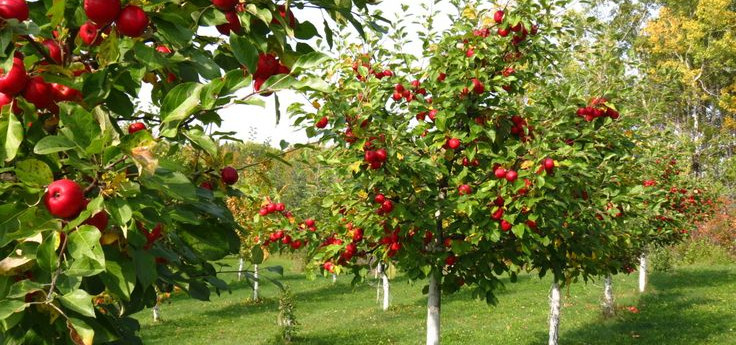1. Choosing The Right Trees
Presumably you already have a fair idea of what you’re going to do with them but if not this section will take you through the options so you can decide what’s best for you. There are many different ways to grow them so maybe there might be a valuable idea or two you hadn’t thought of.
The orchard large or small.
From an oversized lawn, to a paddock or an entire field no matter what the scale, from a few dozen trees to just a handful, all can justifiably be called an orchard.
Here as with all fruit trees spacing needs to be considered to optimize the available space but also ensure there’s enough given for the trees to grow.
In these conditions you will need to grow more vigorously growing trees. So by selecting the right rootstock you can be sure of trees which not only look the part but also have branches that are high enough to walk and mow beneath. They will do to justice the space and provide lots and lots of fruit.
This is where rootstock plays an important part, for the rootstock determines the ultimate size of the tree. There is usually a choice of rootstocks for each fruit type from larger trees to dwarfing ones. Here’s an easy list by fruit type:
For apple trees look for M106 stock, this being the most usual orchard stock making a tree of around 4 metres high and the same wide, good crops and very easy to mow and walk beneath. Although there are other even more vigorous stocks [M111 and M25 for example] M106 is usually more than sufficient and a tree any larger is more difficult to harvest and prune.
Plums, gages and damsons all share the same rootstock and this is St Julien A. It will mature to a tree just slightly higher than M106 for apples and slightly less in width.
Peach, apricot and nectarine are also grown on St Julien.
Cherries should be selected on Colt stock. Again 3 metres+ in height and width is the norm for these, more vigorous seedling rootstocks should be avoided because they can make very big trees.
With Pears look for Quince A stock. Similar dimensions to apples on M106.
Planting distance for all of the above is around 5 metres between. This allows a bit extra between the trees as you don’t want them touching.
FRUIT TREES FOR SMALL GARDENS
The other end of the scale encompasses a broad range of scaled down trees just perfect for smaller areas. These can be incorporated into garden border and have the same habit as a proper orchard sized tree, but much more manageable. They are easier to pick – no ladders required! -and easier to prune too. As above you will need to order trees on the appropriate smaller growing rootstock to make sure you don’t get trees with too much vigour. You will find these smaller growing trees start to fruit sooner after planting than the more vigorous stocks, sometimes even the summer following planting.
Apple trees should be selected on rootstock M9 which is a very good inbetween stock for smaller area’s growing to a little over 2 metres with the same spread. ‘M26’ is just a little bigger at around 3 metres, still easily manageable and a good step up between dwarfing M9 and the vigorously growing kinds. It does need good soil so make sure the planting area is well prepared with a generous amount of organic rich material added first as these trees dislike being too dry in the summer.
Pears should be grown on Quince ‘C’ stock as this is the smallest Pear tree available in general. It can be kept easily to a height and width just slightly above the M9 stock for apples. Avoid other stocks for pears as they are too vigorous for smaller spaces.
With Plum gage and damson we recommend ‘Pixy’ stock – again the same growth expectancy as apples on M9, it is the most satisfactory dwarfing stock for these fruits, easily manageable and not too particular as to soil.
Lastly cherries – Gisele 5 is a great recently introduced dwarf srock for these delicious fruits, it’s productive and precocious and the trees can easily be protected against bird attack it is also ideal for fruit cages where a more vigorous tree will be too big.
FOR ALLOTMENT GROWING We recommend the same stocks as described above in the fruit trees for small gardens section. Most allotments have a height restriction in what you are allowed to grow there and thse stocks all fall within that limitation.
CORDON AND COLUMN TREES If you’re really short on space then these trees really come into their own, as they can be kept in a non spreading form just about 18” across so you can fit a lot into a small space. Versatile, they can be dotted through a garden border, grown in a line beside a path, used to create a break across the garden or even grown in pots. They are also easy to prune, just once at the end of each sumer to keep the perfect pillar form. They crop well and a wide range of apple, pear, plum, gage and cherry can be incorporated. They will grow about 2 metres high and are also often seen trained against a wall. If growing in an open aspect some support will be necessary but a stout bamboo cane is often all that is required, or a 1x1 hardwood tree stake if the area is more exposed. Apple trees and pears trees are most usually grown as cordons plums can also be grown in this way.
FRUIT TREE ARCHES
One of the most beautifying features of any garden must be a fruiting arch. Imagine walking beneath boughs dripping with fruit or festooned with spring blossom …. It’s actually quite easy once the structure is there. Simply use cordons as described above one for each pillar or support. Trim back the side laterals to around 4” each autumn and grow the leader until it has reached the desired length, tying in as it grows. Whether a simple single arch with one tree planted each side as the entrance to the garden or property, or a ‘tunnel’ of several the effect is magical.
GROWING AGAINST WALLS AND FENCES
There are three types of fruit tree suitable for this. The cordons described above, the espalier and the fan. Espalier tends to be the most popular as it ius the most well known [although sometimes confused mystifyingly with the simpler form of the cordon] but cordons enable a wider range of varieties to be grown in a smaller space because of the closer planting distance. Espaliers need 2 metres+ in width with the same in height for each tree. Fans need the same. Cordons can be grown around 60cm’s apart.
Espalier is suitable for apple and pear only.
Fan can be utilized for apple, pear, plum, gage and cherry or peach/nectarine.
Cordons are used for apple, pear and plum.
You will need to affix rubber coated wite training wires fir the fan and espalier tree – rubber coated because it will not chafe against moving branches and damage them. For espaliers these should be around 24” from the ground for the first tier and 48” for the second set of branches. For fans you need 3 or 4 sets of wire. Cordons can often be grown as self supporting against a wall or fence or just supported with a good grade bamboo cane.
One word of caution when planting against fences and walls – it can be very dry where it may be sheltered from prevailing rain and this is especially the case with hot sunny walls of a southerly or westerly aspect. Improve the soil as much as you can with plenty of organic matter and be prepared to offer plenty of additional water the first season following planting until they are established.
FRUIT TREES ON THE PATIO
What could be more pleasurable than sitting amongst your miniature fruit trees enjoying a summer cocktail with friends and family?! It doesn’t have to be a full blown patio of course, any paved area such as a wide path can be utilized practically with a selection of fruit trees grown in containers. Or you may wish to build a raised bed of around 30” depth in which to plant them instead.
For container growing a 20 litre capacity container is ideal, there’s no need to go any bigger as these are small trees on small rootstocks and this makes them easily moved around if necessary as well. Fill with a loam based compost and use slow release fertilizer granules for ease of feeding.
Select the same stocks as those recommended in the section for fruit trees for small gardens earlier in this article.
Apples, pears, plums, gage, damson, cherry, apricot, peach and nectarine are all more than suitable. And don’t forget to consider the cordon columnar types for simplicity of form, space saving values and ease of pruning.
3. Pruning And General Aftercare
Pruning
This is a subject that s often over-complicated to be honest, and whilst it is definitely true to say your trees won’t reach their full potential without some pruning with just some simple guidance if followed will give more than satisfactory results when it comes to keeping them shapely and ensuring good crops [trees which are not pruned often fail to yield well]
For bush trees on all rootstocks the season following planting, this consists of pruning back all new stronger upright growths to about one third of their current length and this should be done in late summer or early autumn. Trim the leader [which is the dominant most upright main growth at the top] as well. Any weak branches should be removed cleanly at the base. At the same time look at the lower branches. It’s usual for bush trees to be grown with a clear stem so now is the time to heighten it to the required length by removing lower branches completely.
The same rule applies whether vigorous or dwarfing trees but it does depend on the growth produced, for smaller growing trees keep it on the lighter side if necessary.
Cordons and columns are even easier; simply reduce all the side shoots up the main stem to about 3”, again in late summer or early autumn. Reduce the leader as well. Subsequent seasons follows the same principal. It’s normal for these trees to be grown with short laterals more or less down to the ground.
General aftercare
It’s a given to ensure the area immediately surrounding the trees is kept weed free because otherwise these will compete for moisture and nutrients. Avoid using herbicides close to the trees.
Protection from rabbits and or deer is also wise unless you live in a very urban area. There are spiral tree guards on the market which are inexpensive and easy to wrap around the trunk of the tree.
Feeding will increase the health and yield of your trees; there are many brands on the market but we still like the old standby’s potash or blood fish and bone which can be simply raked into the soil around the tree and lightly watered in. We also like to use a foliar feed such as maxicrop which is a seaweed extract, especially if the trees are looking off colour, it has a more immediate effect as the nutrients are readily absorbed directly through the leaves.
Watering for young trees is often necessary the first summer following planting as the trees won’t be fully established. This is best done in the early morning, use a hose if possible or a watering can with no rose – give them a good soaking and apply directly to the base of the tree.


